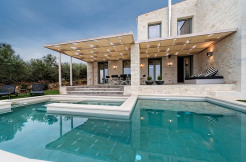
NW Exclusive 4bd Villa
Part of a complex of 2 totally brand-new structures, offering… More Details
from 350€ /NightThe ancient city of Phalasarna was already inhabited in the Minoan period and in the Archaic and Classical years. The city was at its peak between the middle of the 4th century B.C. and 67 B.C. when it was destroyed by the Romans, most probably because it had become a pirate’s stronghold. The channels leading into the fortified harbour were blocked with huge rocks and it went out of use.
In 500 A.D (the date is still being debated) the West of Crete lifted and raised Falasarna by 9 meters and the harbour was turned into dry land and buried under tons of landfill.
The very first excavations of the harbour started in 1966 and are still ongoing, gradually unveiling the ancient harbour, the city and the necropolis.
Phalasarna was one of the most powerful naval cities of Crete in the Hellenistic period. It was a fortified citadel with a southward orientation. Ruins of temples, probably consecrated to the goddess Artemis – Diktynna can be found on top of the ridge above the city. 550m of the city walls are still intact, doubled in some places, and date back to the second half of the 4th century B.C..
Phalasarna had an enclosed military harbour fortified by an extension of the city walls. The harbour fortification had four towers linked by walls and quays. The south-east tower is the best preserved one.
The harbour was linked to the sea by two channels. The shallower channel was used for the circulation of sea water or small boats. Excavations have revealed blocks of built quay with mooring stakes. To the North a second smaller artificial basin probably has to do with the ancient shipyards which have not yet been excavated.
A pavement leading from the harbour to the acropolis was discovered next to the second basin as well as five small cisterns which had to do with the public baths of the 4th-3rd c. B.C.
The ancient quarries are located at the South of the harbour (near where the large rock-cut “throne” stands). Near the quarries there is also a rock-cut fish tank 25m² in size.
The necropolis is situated outside the city walls and covers a large area south and east of the harbour. It dates from the Archaic and Hellenistic periods. The tomb types include pithos burials, pit graves, cist graves and rock-cut graves.

Part of a complex of 2 totally brand-new structures, offering… More Details
from 350€ /Night
Faidra’s Olive Grove is the best selling villa in Crete island… More Details
from 200€ /Night
Build with a unique classic design and excellent quality materials… More Details
from 250€ /Night